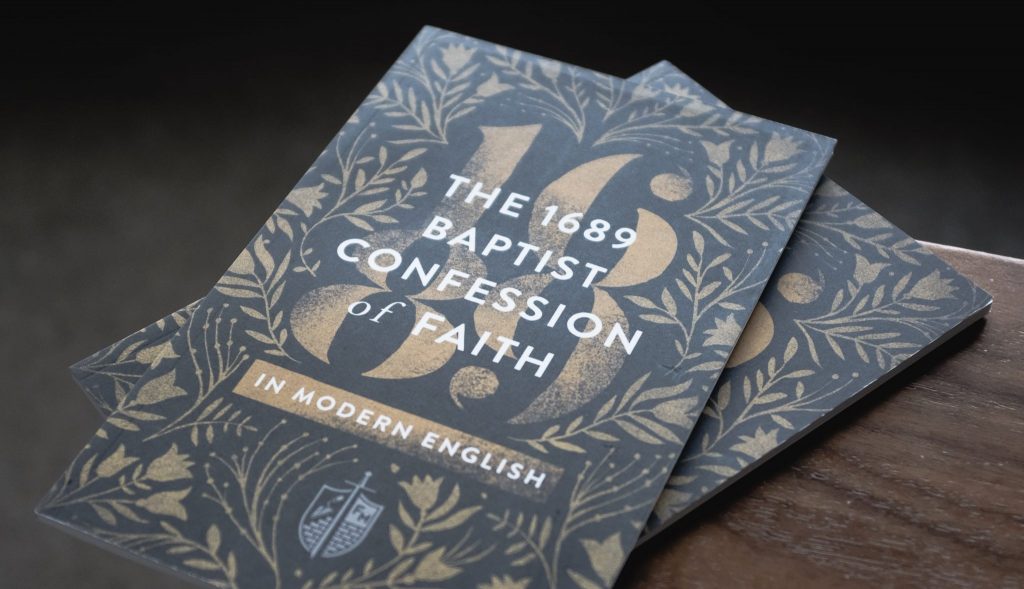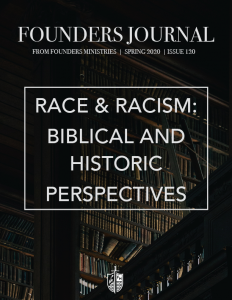James Renihan. Baptist Symbolics: Volume 1.
For the Vindication of the Truth: A Brief Exposition of the First London Baptist Confession of Faith.
Cape Coral, FL: Founders Press.
If you are just about to begin your adventure into this world of confessional exposition, get ready for an encounter with a work of art. This examination of the First London Confession of the Particular Baptists (or “baptistic congregationalists”) combines so many pertinent elements in an interesting and orderly fashion that the reader is as much entertained by the organization as he is informed by the content of the narrative.
Before listing these aspects of composition that I found admirable and engaging, I want to make two personal points about the confession itself, ideas that Dr. Renihan has woven into his narrative. First, the confession itself as a literary structure holds importance for Baptist life in a way that it does not for any other denomination. The confession arose basically from the defense John Spilsbery gave for the right [obligation!] to begin a church based on the immersion of believers only. When Spilsbery’s action in forming a church on such a basis was challenged, he wrote a defense of reinstituting baptism de novo apart from any succession in the ordinance from previous administrators. He enunciated four principles of church formation, or “constitutional causes,” in The Lawfull Subjects of Baptisme. First must come the Word of God “fitting and preparing of the matter for the forme.” The preaching and reading of the word humbles and brings down the proud heart of man and makes him fit matter for the body of Christ, the church. Second, a “confession of faith” declares the “fitnes of the matter for the forme.” The power of the Gospel “shining into the heart of man” so convinces the sinner of its truth that its leaven “seasons and sweetens the whole man.” The Word operates like a fire that “breaks forth and discovers itself” with such clarity in “such as have it,” that they delineate specific truths from that Word. A confession of faith consisting of particular doctrines naturally develops. Others so prepared come to the same judgement concerning these truths. This leads to the third “constituting cause” of a church. The believers so fitted by the Word now covenant to be a body of believers joined by “free and mutual consent and agreement upon the practice of that truth so by God revealed, and by faith received.” This voluntary covenant precedes the ordinances. It is in the agreement indicated by such a covenant relationship that the agreeing body then warrants the corporate practice of the ordinances of the New Testament. The seal then is set by baptism, an obedient response to apostolic teaching under the authority of Christ himself. This baptism is a confession of faith both in the internal submission to Christ’s redemptive work and in the external expression of the body of truths incorporated in the written confession. The fourth cause follows, the Spirit’s work in knitting and uniting their hearts together in truth. Unity in love and truth progresses in the body by means of the Spirit’s acting on the proclamation of the bible. A corporate witness to propositional truths provides the only clear evidence that such a work of the Spirit has, in fact, occurred.
Spilsbery considered this as necessary for the being of the church. He declared in no uncertain terms that saving faith must be manifest in the hearty approval and assertion of a body of propositional truths. No church, and thus no baptism, could exist apart from submission to orthodox evangelicalism embodied in a confession of faith. His own ten-point confession is included as an appendix in this volume. Submission to such constituted the covenantal agreement necessary before baptism in Spilsbery’s doctrine of the church. The First London Confession, therefore, not only gives a public witness to truth taught by the churches but to heart commitments of each of the members expressed before they are received to baptism and membership.
Another remark about the confession is its comprehensive trinitarian witness to Scripture. This serves to justify the confidence that a coherent and consistent statement of faith can be produced from the written word of God. The doctrine of God affirms the full truthfulness of Scripture in saying “Truth is that whereby he [God] declares that alone which he hath decreed, and though his sayings may seeme to sound sometimes another thing, yet the sense of them doth always agree with the decree” (article 3). Scripture never lies. Article 8, to which Renihan refers at the key critical developments of revelatory truth says, “In this written Word God hath plainly revealed whatsoever he hath thought needful for us to know, believe, and acknowledge, touching the Nature and Office of Christ, in whom all the promises are Yea and Amen to the praise of God.” We are pointed forward to the offices of Christ. In his office as prophet we find that Christ “hath perfectly revealed the whole will of God out of the bosome of the Father, that is needful for his servants to know believe, and obey.” The prophetic office of Christ, therefore, confirms the very Scripture that has taught us about these messianic offices. The Scriptures teach us all we need to know about Christ as prophet, and Christ as prophet reconfirms what Scripture tell us we need to “know, believe, and obey [acknowledge].” Beyond that, the effectual operations of the Spirit in salvation include his work in teaching the elect “to see, know, and beleeve the truth of the Scriptures, & not onely so, but the excellencie of them above all other writings and things in the world.” Why? Because they “hold forth the glory of God in his attributes [article 3], the excellency of Christ in his nature and offices [articles 17-21], and the power and fulnesse of the Spirit in its workings and operations” [articles 22-26]. The doctrine of Scripture, therefore, promoted in the Confession is fully comprehensive in the testimony borne to its truthfulness by each person of the triune God. It breathes the air of full submission to the Bible, giving no room for speculations or additions, or irrelevant extrapolations from men. Finally, the confessors affirm that even if they do not win the confidence of their Protestant contemporaries and are viewed as in vital error, they confess, “that after the way which they call heresie, worship we the God of our Fathers, beleeving all things which are written in the Law and in the Prophets and Apostles, desiring from our soules to disclaime all heresies and opinions which are not after Christ” (article 52).
Thus, seeing the vital importance for the process of composing a confession and the central place of Scripture in that composition, I want to delineate seven compelling traits of Jim Renihan’s exposition of this confession.
First, this is simply an exposition. What does the confession mean? Why did its writers organize it in this specific way? How do the various articles of faith relate to one another? What do certain words mean? How do these words and ideas relate to the broader theological context, most importantly the doctrinal expositions that were maturing in English Puritanism? This expositional quality is an education in itself.
Second, this is an adventure in polemics. How the plain meaning and the contextual clarity of the simple statements of the confession can be twisted by contrarians to the new sect of antipaedobaptists entertains as much as it startles. Enmity is a creative force in its attempts to destroy. On the other hand, the willingness of the new Baptists to concede at every point possible for the sake of peace and the removal of any suspicion of heresy demonstrates the scriptural principle, “A harvest of righteousness is sown in peace by those who make peace” (James 3:18).
Third, this is a fascinating study in the use of sources. The matching of modern commentators on the confession placed alongside the antiquarian contemporaries of these seven churches that produced the confession is a work of a seasoned thinker and researcher in difficult historical relations. The richness of Renihan’s knowledge and skillful use of primary sources should encourage every historian with the dignity of his calling and the approximation of truth that is possible through hard work. Arising from these sources that hovered around the series of editions of the confession is an explanation of concepts and contextualized language that exhibits an entirely credible display of the purpose of the confession.
Fourth, concerning that purpose, we find that the doctrinal exposition not only was intended to be instructive to the churches and their membership, but to align the Baptists with the broad Reformed orthodoxy of the Puritans, the Presbyterians, the Anglicans, and the Independents. They wanted first to establish the conscientiously-held truth that they were orthodox in their doctrine of Scripture, the understanding of the Trinity, Christology, the doctrines of grace, and their prayerfulness for and submission to the government in all lawful matters. God alone is Lord of the conscience and no man can intrude there. While accomplishing this work of stating objective truth, they also wanted to manifest their heartfelt fellowship with orthodox believers in non-baptistic religious bodies. This energy for orthodoxy, pointed out clearly and fittingly throughout this work, is an important point. Much of the twentieth century saw a vaporizing of this primary commitment and shifted the identity of Baptists simply to issues of liberty of conscience. Instead of seeing liberty of conscience as an implication of new covenant orthodoxy properly conceived, many historians condensed Baptist identity to that single affirmation, along with the right of private interpretation. The effect of this reductionistic project was to thrust aside the confessional element that gave rise to Baptists as a flowering of Protestantism into a consistent ecclesiology. Renihan’s exposition is a clear reminder f the necessary dependency of true liberty of Conscience on a firm commitment to biblical truth.
Fifth, Renihan weaves a marvelous tapestry of arguments between the Baptists, their foes, and their friends. One may want to doubt me when I say that this interweaving of theologically precise vocabulary, oddly constructed arguments, and scholastic logic is fascinating and entertaining, but the doubt would not be fitting. The manner in which Renihan shows how ideas and phrases and vocabulary from one writer are used constructively by another and implanted in the confession, while others dispute the accuracy of arguments and condemn the [remote!] implications of certain phrases is a fascinating study of human interaction. It also shows how iron sharpens iron and how theological clarity often is a community work. Renihan’s appendices reveal his own skill in relevant polemical writing.
Sixth, the author’s care in getting behind the articles to the larger discussion is frequently gripping and yields surprising transparency of meaning. For example, his discussion of article twenty-five on the preaching of the gospel in relation to preparations of the law is a masterful work in displaying the historical context of doctrinal vocabulary. He demonstrates how words, like “absolutely,” “preparations,” “terrors,” “naked,” “sinner,” “ungodly,” work together to produce a profound doctrinal and experimental affirmation. His display of the various nuances of meaning and the interactions of theologians writing on this important issue is deeply instructive. Again, may I say, sections like that produce a deep sense of satisfaction in the beauty and symmetry of biblical truth and the sanctified artistic impulse that works toward such a cogent display of reality.
Seventh, Jim Renihan is himself engulfed in the goodness of the confessional content and purpose. Not only does he express confidence that the framers of the confession were in the “mainstream of federal thought” and that they were “using common language to describe” their ascription to confessional biblical theology, but he also seems to exude delight at times with a phrase like, “It is wonderful how this is expressed.” When a reader knows that the writer is fully on board with an important subject, has a personal happiness in the content of his matter, and is unafraid to express his unity with certain ideas, it goes a long way to help the reader enjoy and embrace the good things that are set before him. I believe this will be your experience in your journey through this exposition.






















